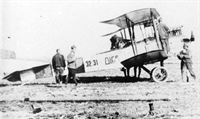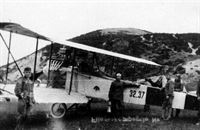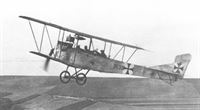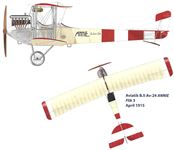
Описание
Страна: Австро-Венгрия
Год: 1914
А.Александров, Г.Петров Крылатые пленники России
С "Авиатиками Б. II" русские летчики познакомились благодаря попавшим в плен австрийским самолетам. Германская компания "Аутомобил унд Авиатик АГ" (Aviatik В. II; Automobil und Aviatik AG) появилась в 1911 г. в результате слияния двух производств. Довольно быстро выдвинувшись в ряды крупнейших авиастроительных фирм, в 1914 г. она дала рождение дочернему предприятию в Австро-Венгрии, венскому "Флюгцойгфабрик Авиатик" (Oesterreichisch-Ungarische Flugzeugfabrik Aviatik), которое воспроизводило немецкие конструкции и создавало свои собственные. В Германии "Авиатик Б. I" существовал в двух- и трехстоечной конфигурации, а годом его создания был 1914-й. Отличительной особенностью модели служили слегка стреловидные крылья; у "Авиатика Б. II" 1915 г. она исчезла, а 120-сильный "Мерседес" сменил 100-сильный. Австрийский "Б-второй" возник летом 1914 г. на базе оригинальной германской модели П14 (P14), сохранив первоначально ее черты, но неся двигатель "Даймлер" 120 л. с. Летная практика выявила недостатки в управлении, для устранения которых потребовалось увеличить элероны и рули, и слабость мотора, после чего некоторые аппараты получили 150-сильный "Даймлер". Несмотря на улучшения, скороподъемность оставалась поразительно малой: высота 1000 м достигалась в течение полутора часов! Австрийский "Авиатик Б. II" выпускался в нескольких сериях: 32, 32.7 и 34-й. Первые две использовались главным образом на русском фронте, где служили в 3,11,13 и 14-м авиаотрядах в период с сентября 1914 по сентябрь 1915 гг. Серия 34 была модернизированной, на ее аэропланах стояли 150-сильные "Даймлеры", лобовые коробчатые радиаторы (вместо боковых "Хазет") и иногда передатчики беспроволочного телеграфа. Применение усовершенствованных "Авиатиков" длилось с сентября 1915 г. примерно до начала 1917 г., на Востоке они летали в 1,3,5, 11, 13, 14, 18, 20, 22, 26 и 27-м отрядах и зарекомендовали себя надежными многофункциональными аппаратами. На фотографии 16 можно увидеть трофейный "Авиатик Б. II" - одну из ранних машин с "недоразвитыми" рулевыми поверхностями. Самолет лишен каких бы то ни было опознавательных знаков, по крайней мере на фюзеляже и верхних крыльях.
"Попался!" - думали, вероятно, солдаты 7-го корпусного авиаотряда, транспортируя другой "Авиатик" серии 32, с номером 32.32 и именем IRMUS на фюзеляже (17, из коллекции ЦГАКФФД). Стоит обратить внимание на австрийские опознавательные знаки - красные и белые полосы на крыльях, корпусе и руле поворота, и измененную форму последнего и рулей глубины. Про аппарат 34-й серии, с номером 34.18, можно было бы сказать: "Долетался!" (18, 19). 5 января 1916 г. этот самолет, пилотируемый Гансом Грейнером (звание неизвестно) и наблюдателем оберлейтенантом Эгеном Кайзером (Hans Greiner, Eugen Kaiser) из Flik 5, выполнял воздушную разведку, но из-за поломки двигателя совершил вынужденную посадку в районе Здолбуново. Его отремонтировали, и он служил в нашем 18-м корпусном авиаотряде. Не исключено, что он же, но уже с русскими кокардами, изображен на следующем снимке (20). Очевидно, что австрийский "второй" сохранил стреловидные крылья германского "первого", тогда как пулемет "Кольт" (Colt) в задней кабине (у машин серии 34 пилот находился в передней) являлся чисто русским новшеством. В армейской авиации "Кольт" ("Кольт-Браунинг" обр. 1895-1914 гг., калибр 7,62 мм, вес 15,87 кг, скорострельность 480-500 выстрелов в минуту) был одним из наиболее распространенных видов автоматического вооружения, а пропеллеры марки "Интеграл" пользовались просто всеобщей популярностью.
Описание:
- А.Александров, Г.Петров Крылатые пленники России
- P.Grosz, G.Haddow, P.Shiemer Austro-Hungarian Army Aircraft of World War One (Flying Machines)
- E.Hauke, W.Schroeder, B.Totschinger Die Flugzeuge der k.u.k. Luftfahrtruppe und Seeflieger 1914-1918
Фотографии
-
P.Grosz, G.Haddow, P.Shiemer - Austro-Hungarian Army Aircraft of World War One /Flying Machines/
Aviatik B.II 32.12, Flek 8
-
J.Herris - Aviatik Aircraft of WWI /Centennial Perspective/ (10)
Austro-Hungarian Aviatik B.II 32.12 assigned to Flek 8.
-
E.Hauke, W.Schroeder, B.Totschinger - Die Flugzeuge der k.u.k. Luftfahrtruppe und Seeflieger 1914-1918
Aviatik B II 34.08 Flik 14
-
E.Hauke, W.Schroeder, B.Totschinger - Die Flugzeuge der k.u.k. Luftfahrtruppe und Seeflieger 1914-1918
Aviatik B II 34.46 Flik 14
-
J.Herris - Aviatik Aircraft of WWI /Centennial Perspective/ (10)
Austro-Hungarian Aviatik B.II Av-18 assigned to Flik 8.
-
J.Herris - Aviatik Aircraft of WWI /Centennial Perspective/ (10)
Austro-Hungarian Aviatik B.II Av-24 ANNIE assigned to Flik 3.
-
A.Olejko - Habsburg Wings 1915 /Aeronaut/
Aviatik B.II Av-24 Annie
-
В.Кондратьев - Самолеты первой мировой войны
"Авиатик" B-I, 1-я эскадрилья ВВС Австро-Венгрии, конец 1914г.
-
A.Olejko - Habsburg Wings 1915 /Aeronaut/
Flik 1 field airfield in Jasien on January 4, 1915... In the photo in the cabins of the Aviatik B.I "Durch" a veteran of postal flights to the besieged Przemysl Fortress, they are sitting from left to right: Oblt. Benno Fiala von Fernbrug from Flik 1 and Oblt. Ing. Rudolf Stanger from Flik 8 and an ex cavalryman Oblt Max Hesse is standing next to the plane with his pet - a white Spitz named Muzzl - Source: Fotoarchiv SAW-KA.
The Austrian Air Arm deployed a number of units to join the campaign against Russia; here an Albatros (Aviatik ???) B1 of Fliegerkompanie 1 is at Brzesko in late 1914. -
A.Olejko - Habsburg Wings 1915 /Aeronaut/
Flik 1 airfield in Jasien on January 4, 1915... In the photo in the cabins of the Aviatik B.I "Durch", a veteran of postal flights to the besieged Przemysl Fortress, they are sitting from left to right: Oblt. Benno Fiala von Fernbrug from Flik 1 and Oblt. Ing. Rudolf Stanger from Flik 8 and an ex cavalryman Oblt Max Hesse is standing next to the plane with his pet - a white Spitz named Muzzl - Source: Fotoarchiv SAW-KA.
-
A.Olejko - Habsburg Wings 1915 /Aeronaut/
German-built Aviatik B.I 31.03 was powered by a 100 hp Mercedes and purchased by Austria before the war. Source: Aeronaut.
-
E.Hauke, W.Schroeder, B.Totschinger - Die Flugzeuge der k.u.k. Luftfahrtruppe und Seeflieger 1914-1918
Aviatik B.I, 31.09 als Schulflugzeug mit Doppelsteuer; die Beschädigütigen verursachte eine andere Maschine beim Rollen
Aviatik B.I, 31.09 в качестве учебно-тренировочного самолета с двойным управлением; повреждение нанес другой самолет во время руления -
E.Hauke, W.Schroeder, B.Totschinger - Die Flugzeuge der k.u.k. Luftfahrtruppe und Seeflieger 1914-1918
Aviatik B.I 31.13 als Schulflugzeug mit Doppelsteuer
Aviatik B.I 31.13, учебно-тренировочный самолет с двойным управлением -
A.Olejko - Habsburg Wings 1915 /Aeronaut/
Carrying the original designation, the Aviatik o.Av 24 Annie of Flik 3 was photographed at the Minay airfield on 26 April 1915. The B.II series 32 did not differ appreciably from the original P 14 design with exception of inverse-tapered ailerons and a large balanced rudder.
Aviatik B.I ö.Av-24 bei Flik 3 in Minaj, 26. April 1915; Flugzeug später mit 31.24 bezeichnet, wurde zum Typ B.II umgebaut, Bezeichnung 32.01, persönliches Kennzeichen „Annie”
Aviatik B.I. Av-24 на Flik 3 в Минае, 26 апреля 1915 г .; Самолет, получивший обозначение 31.24, был переоборудован в тип B.II, номер 32.01, персональный идентификатор "Энни" -
A.Olejko - War Wings Over Galicia 1918-1919 /Aeronaut/
The era of biplanes ... At the outbreak of the Great War, the Austro-Hungarian aviation in which a large group of Poles served mainly used biplane aircraft of their own production, e.g. Aviatik B.I, as well as German production of the Albatros type B.I. In the photograph is an airfield scene from the initial period of the fighting. Annie was an Aviatik (o Av-24) B.II series 32 assigned to Flik 3 and was powered by a 120 hp Daimler engine. (G. Penz's collection)
-
P.Grosz, G.Haddow, P.Shiemer - Austro-Hungarian Army Aircraft of World War One /Flying Machines/
Still awaiting positive identification, it is believed that this photo shows the modified Aviatik 30.03, powered by a 150 hp Daimler engine and fitted with a box radiator.
-
P.Grosz, G.Haddow, P.Shiemer - Austro-Hungarian Army Aircraft of World War One /Flying Machines/
Aviatik B.II 32.12 with Hauptmann Karl Banfield and his students at Flek 4 in Szombathely.
-
P.Grosz, G.Haddow, P.Shiemer - Austro-Hungarian Army Aircraft of World War One /Flying Machines/
Flight instructor Leutnant Stephan Wagner posing in Aviatik B.II 32.13 at Wiener-Neustadt. The pilot’s cockpit was in the front. The Hazet side radiators have been replaced by a box radiator over the engine.
-
A.Olejko - Habsburg Wings 1915 /Aeronaut/
Aviatik B.II 32.15 at the front was powered by a 120 hp Austro-Daimler. Source: Aeronaut.
-
A.Olejko - Habsburg Wings 1915 /Aeronaut/
Aviatik B.II Av-3 32.15 at the front was powered by a 120 hp Austro-Daimler. Source: Aeronaut.
-
E.Hauke, W.Schroeder, B.Totschinger - Die Flugzeuge der k.u.k. Luftfahrtruppe und Seeflieger 1914-1918
Aviatik B.II 32.31 mit persönlichem Kennzeichen „Olga”
Aviatik B.II 32.31 с персональным идентификатором "Ольга" -
E.Hauke, W.Schroeder, B.Totschinger - Die Flugzeuge der k.u.k. Luftfahrtruppe und Seeflieger 1914-1918
Aviatik B.II 32.37 beim Vorbereiten zu einem Feindflug
Aviatik B.II 32.37 готовится к вылету -
A.Olejko - Habsburg Wings 1915 /Aeronaut/
Aviatik B.II 32.37 after crashing into a building on the airfield. Source: Aeronaut.
-
P.Grosz, G.Haddow, P.Shiemer - Austro-Hungarian Army Aircraft of World War One /Flying Machines/
An Aviatik B.II series 32.7 trainer showing the balanced elevator installed when the aircraft were modified for dual control.
-
P.Grosz, G.Haddow, P.Shiemer - Austro-Hungarian Army Aircraft of World War One /Flying Machines/
The Aviatik B.II 32.88 dual-control trainer was modified from aircraft 32.56. The control column extension can be seen under the rear cockpit.
Aviatik B.II 32.88 Doppelsteuer-Schulflugzeug, Umbauserie aus Ba 32
Учебно-тренировочный самолет с двойным управлением Aviatik B.II 32.88, переоборудованный из Ba 32 -
P.Grosz, G.Haddow, P.Shiemer - Austro-Hungarian Army Aircraft of World War One /Flying Machines/
Aviatik B.II 34.05 was one of the 12 B.II machines accepted at Aspern in September 1915. It served with Flik 3 from October 1915 to October 1916 on the Eastern Front. It is shown here after conversion to a dual-control trainer.
-
P.Grosz, G.Haddow, P.Shiemer - Austro-Hungarian Army Aircraft of World War One /Flying Machines/
Aviatik B.II 34.05 of Flik 3 on the Gaje Starobrodzkie airfield (Russian Front), 1 February 1916. Carrying a hand-held weapon, such as the Mannlicher M 95 rifle, sufficed at this stage in the war.
-
A.Olejko - Habsburg Wings 1915 /Aeronaut/
Galicia 1914... Oblt. Guido Georgievic (first from left) and Oblt. Andreas Alexay from Flik. 5. at the Baranow Sandomierski field airport, next to the Lloyd C.I (???) aircraft, source: Fotoarchiv SAW-KA.
-
E.Hauke, W.Schroeder, B.Totschinger - Die Flugzeuge der k.u.k. Luftfahrtruppe und Seeflieger 1914-1918
This unarmed Aviatik B II, serial 34.08, was built by the Austrian-based branch of the company for service with the Austro-Hungarian forces, powered by a 100hp Mercedes. Of late 1914 origins, only a relatively small number of B IIs were produced, the type being quickly superseded by the more powerful, cleaner and armed Aviatik C I. As was often the case, once relegated from front-line service, the type found a second career with advanced flying training units, the Aviatik B II known to have served in this role with FEA 9 at Darmstadt during 1916.
-
P.Grosz, G.Haddow, P.Shiemer - Austro-Hungarian Army Aircraft of World War One /Flying Machines/
Aviatik B.II 34.26 of Flik 8 on the Isonzo Front in the fall of 1915. This machine was equipped with three pivot mounts for the observer’s machine gun.
-
E.Hauke, W.Schroeder, B.Totschinger - Die Flugzeuge der k.u.k. Luftfahrtruppe und Seeflieger 1914-1918
Aviatik B.II 34.28 in Aspern beim Einfliegen, Flugzeug kam zur Flik 12 an die Südwestfront
Aviatik B.II 34.28 в Асперне, летал во Flik 12 на юго-западном фронте -
P.Grosz, G.Haddow, P.Shiemer - Austro-Hungarian Army Aircraft of World War One /Flying Machines/
In January 1916, some B.II series 34 biplanes were retro-fitted in the field with the tubular gun ring. Aviatik B.II 34.30 was attached to Flik 5 in April 1916 and Flik 3 in July-September 1916. Used as a trainer it was written-off in July 1918.
-
E.Hauke, W.Schroeder, B.Totschinger - Die Flugzeuge der k.u.k. Luftfahrtruppe und Seeflieger 1914-1918
Aviatik B.II 34.39 bei der Flik 18 an der Ostfront
-
A.Olejko - Habsburg Wings 1915 /Aeronaut/
Aviatik B.II Elsa. Sources: Aeronaut.
-
A.Olejko - Habsburg Wings 1915 /Aeronaut/
Flik 5 airfield in Baranow Sandomierski, October 12-13, 1914... In the photo in an Aviatik B.I plane: in the observation cabin of Oblt. Ferdinand (Karl?) Banfield in the cockpit Oblt. (Hptm.) Josef Bendik - Source: Fotoarchiv SAW-KA.
-
A.Olejko - Habsburg Wings 1915 /Aeronaut/
Przemysl 1914 - the sting of Aviatik B.I... Machine gun mounted in the observer's cabin: source: SAW-KA Wien
-
A.Olejko - Habsburg Wings 1915 /Aeronaut/
Galicia 1914... Oblt. Guido Georgievic (first from left) and Oblt. Andreas Alexay from Flik 5 at the Baranow Sandomierski field airport, next to the Aviatik B.I aircraft - source: Fotoarchiv SAW-KA.
-
A.Olejko - Habsburg Wings 1915 /Aeronaut/
Military Galicia... In the photo, the Flik 5 airfield in Baranow Sandomierski. Next to the Aviatik B.I, there are members of the flying personnel standing and sitting: the first on the left Oblt Ferdinand (Karl?) Banfield, second left Oblt. Andreas Alexay, first from right Oblt. Guido Georgievic - Source: Fotoarchiv SAW-KA.
-
A.Olejko - Habsburg Wings 1915 /Aeronaut/
From the photo album of Flik 5... Oblt. Johan Mandi (first from left) and Oblt. Max Macher of Flik 5 at the Baranow Sandomierski field airport, next to the Aviatik B.I aircraft - source: Fotoarchiv SAW-KA.
-
A.Olejko - Habsburg Wings 1915 /Aeronaut/
The harsh winter of 1915 did not stop the postal line to the Przemysl Fortress... Aviatik B.I planes in the "polar" scenery of the Przemysl-Zurawica airport. SAW-KA Wien collection
-
A.Olejko - Habsburg Wings 1915 /Aeronaut/
The harsh winter of 1915 did not stop the postal line to the Przemysl Fortress... Aviatik B.I planes in the "polar" scenery of the Przemysl-Zurawica airport. SAW-KA Wien collection
-
A.Olejko - Habsburg Wings 1915 /Aeronaut/
The harsh winter of 1915 did not stop the postal line to the Przemysl Fortress... Aviatik B.I planes in the "polar" scenery of the Przemysl-Zurawica airport. - SAW-KA Wien collection
-
A.Olejko - Habsburg Wings 1915 /Aeronaut/
On 12-13 October 1914, Baranow Sandomierski became the Flik 5 field airfield... In the photo in the cabins of the Aviatik B.I - in the observation cabin of Oblt. Ferdinand Cavallar von Grapensburg, in the cockpit Oblt. Eduard Fritsch - Source: Fotoarchiv SAW-KA.
-
A.Olejko - Habsburg Wings 1915 /Aeronaut/
AOK and the military command of the Imperial-Royal Army constantly needed up-to-date information about the enemy. Winter was not an obstacle here... The photo shows the frozen Flik crew. 6. after a combat flight on the Serbian Front in the winter of 1915 - Aviatik B II aircraft in the background - source: Fotoarchiv SAW-KA Wien
-
A.Olejko - Habsburg Wings 1915 /Aeronaut/
The reality of winter front service... In the photo the Flik 6 crew in front of a Lohner Pfeilflieger (???). And just before the flight on the Italian Front - source: Fotoarchiv SAW-KA Wien
-
A.Olejko - Habsburg Wings 1915 /Aeronaut/
So they fly on this... This is how you can read the speech of curious glances casted by German army soldiers towards a foyer transported somewhere in Eastern Galicia in 1915 in the hall behind... a cart of an Aviatik B.I plane in the colors of the KuK Luftschifferabteilung. source: collections Polish Aviation Museum in Krakow.
-
A.Olejko - Habsburg Wings 1915 /Aeronaut/
"Eyes" of the field command of the 1st Army... The photo shows a field airfield in Nisko where Flik 5 was stationed on 18-28 August 1914 and 10-12 September 1914. Visible tent hangars and Aviatik B.I planes in the colors of KuK Luftschifferabteilung - source: Fotoarchiv SAW-KA.
-
A.Olejko - Habsburg Wings 1915 /Aeronaut/
On 12-13 October 1914, Baranow Sandomierski became the Flik 5 airfield... In the photo, there are transport crates with Aviatik B.I fuselages arranged for transport - source: Fotoarchiv SAW-KA.
-
A.Olejko - Habsburg Wings 1915 /Aeronaut/
Flik 3 in August 1914, it was on the Nord-Ostfront... In the photo, a Lohner B "Pfeilflieger" (???) plane in flight - source: Fotoarchiv SAW-KA.
-
A.Olejko - Habsburg Wings 1915 /Aeronaut/
Flik 3 during the 1914 campaign, on October 15, 1914, it found itself at the airfield in Sanok, assigned to the 2nd Army field... In the photo, Aviatik B.I aircraft during the landing approach - source: Fotoarchiv SAW-KA.
-
A.Olejko - Habsburg Wings 1915 /Aeronaut/
Aviatik B.II 32.37 Av-12 flys over its airfield. Source: Aeronaut.
-
P.Grosz, G.Haddow, P.Shiemer - Austro-Hungarian Army Aircraft of World War One /Flying Machines/
Forty-three Aviatik B.II series 34 biplanes were converted to dual-control trainers. One of these was aircraft 34.40 that was attached to Flek 4 in September 1917.
-
A.Olejko - Habsburg Wings 1915 /Aeronaut/
Popular "pop". Aviatik B.I aircraft from Flik 1 wrecked on New Year's Eve 1914 at the field airfield in Jasien by Oblt. Josef Toth during the take off to the besieged Przemysl Fortress... By the plane from the left: Oblt. Fp. Jillicher, ex cavalryman Oblt Max Hesse, Oblt. Benno Fiala von Fernbrug, Oblt. Ludwig Dumbacher, Oblt. Stefan Horwath and unit commander of Oblt. Josef Smetana. From the right, next to the fuselage, there are crewmembers of the damaged plane, including Oblt. Josef Toth - Source: Fotoarchiv SAW-KA.
-
A.Olejko - Habsburg Wings 1915 /Aeronaut/
Aviatik B.II on its nose. Source: Aeronaut.
-
J.Davilla - Italian Aviation in the First World War. Vol.1: Operations /Centennial Perspective/ (73)
Aviatik B.II Av-24 Annie, Flik 3, April 1915
-
P.Grosz, G.Haddow, P.Shiemer - Austro-Hungarian Army Aircraft of World War One /Flying Machines/
Aviatik B.II 32.12, Flek 8
-
P.Grosz, G.Haddow, P.Shiemer - Austro-Hungarian Army Aircraft of World War One /Flying Machines/
Aviatik B.II Series 32 and 34


































































